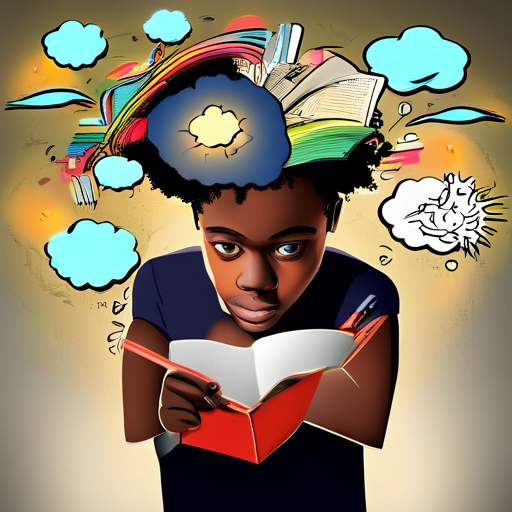Are you struggling with reading fluency? Do you find yourself stumbling over words or struggling to comprehend what you’re reading? One powerful tool that can help improve your reading fluency is visualization.
By using your imagination to create mental images as you read, you can improve your comprehension, retention, and overall reading ability. Visualization is a technique that involves creating mental pictures of what you’re reading.
It allows you to engage your senses and make the text come alive in your mind. When you visualize what you’re reading, you’re more likely to understand and remember it. This is because visualization activates different parts of your brain than simply reading or listening to information.
In this article, we’ll explore the benefits of visualization in improving reading fluency, how it works, and tips for incorporating visualization techniques into your reading practice.
Table of Contents
The Benefits of Visualization in Improving Reading Fluency

The advantages of using visualization to enhance the ability to read smoothly and effortlessly cannot be overstated. When you read a book, it’s important to create mental images of the words you’re reading. This technique can help you understand the text better and improve your reading fluency. Visualization can also help you remember the information you’re reading, making it easier to recall later.
One of the main benefits of visualization is that it helps you to engage with the text. When you imagine the story or information you’re reading, it becomes more real to you. You can see the characters and the setting in your mind, which makes the story more interesting and engaging.
This engagement can help improve your reading speed and fluency, as the more invested you are in the text, the faster you’ll read. Another advantage of visualization is that it helps you to comprehend the text better. When you picture the events or information in your mind, it can help you to understand what’s happening.
This is especially useful when reading more complex texts, such as textbooks or scientific papers. By visualizing the concepts, you can make them easier to understand and remember. In conclusion, using visualization to improve reading fluency has many benefits.
By creating mental images of the text, you can engage with the material, remember it better, and understand it more deeply. So next time you pick up a book, try visualizing the words on the page and see how it can enhance your reading experience.
How Visualization Works

Let’s explore how visualizing while reading can boost your skills! When you read a book, your brain creates images in your mind. Visualization is essentially taking this process a step further by intentionally picturing what you’re reading.
When you visualize, you’re engaging more of your brain in the reading process, which can help improve your comprehension and retention of the material. Visualization works by activating the same parts of your brain that are used when you’re actually seeing something with your eyes.
By creating vivid mental images, you’re essentially tricking your brain into thinking that you’re experiencing the events of the book firsthand. This can help you connect with the material on a deeper level and make it easier to remember what you’re reading.
Additionally, visualization can help you maintain focus while reading, as you’re actively creating a mental movie of the story in your mind. To effectively use visualization while reading, it’s important to engage all of your senses.
Imagine what the characters look like, what the setting feels like, and even what the air smells like. The more details you can visualize, the more immersive and engaging the experience will be. With practice, you’ll find that visualization becomes second nature and that you’re able to use it to improve your reading fluency in a variety of contexts.
Tips for Incorporating Visualization Techniques

You can enhance your comprehension and retention of material by engaging all of your senses and creating vivid mental images while you read, making the experience more immersive and engaging.
To start, try to activate your imagination by visualizing the setting, characters, and actions in the text. You can also use your senses to imagine the sounds, smells, and textures that are present in the story.
Another tip for incorporating visualization techniques is to actively engage with the text. Take notes on what you’re reading and highlight key phrases or words that stand out to you. Use those notes as a reference point to help you create mental images that are more vivid and detailed. By doing so, you’ll be able to immerse yourself in the story and better understand the plot and characters.
Lastly, try to practice visualization on a regular basis. Set aside some time each day to read and visualize a story. Over time, you’ll develop a stronger ability to create mental images and engage all of your senses while reading. This will ultimately improve your reading fluency and comprehension, making it a valuable skill to have in both academic and personal settings.
Additional Resources for Improving Reading Fluency

Want to boost your skills and become a more confident reader? Check out these extra resources that can help you enhance your understanding and enjoyment of books!
One great tool is the Reading Rockets website, which offers a wealth of information and activities for readers of all ages. From tips for parents on how to support their children’s reading development, to strategies for struggling readers, this site has it all. Plus, their collection of videos featuring real teachers and students can provide inspiration and motivation for anyone looking to improve their reading fluency.
Another helpful resource is the online platform, Bookshare. This website provides access to a massive collection of books in accessible formats for those who struggle with traditional print materials, such as individuals with dyslexia or visual impairments. By using this service, readers can access books in audio, braille, and other formats that can help improve their reading fluency and comprehension. Plus, with a low subscription fee, it’s an affordable option for anyone looking to expand their reading options.
Finally, don’t forget about the power of audiobooks! Listening to books can help readers improve their vocabulary, comprehension, and overall fluency. Plus, it can be a great way to enjoy books on the go, whether you’re driving, exercising, or doing household chores. With services like Audible and Overdrive, there are plenty of options for accessing audiobooks, so you’re sure to find something that suits your interests and reading level.
So why not give it a try and see how audiobooks can enhance your reading experience?
Frequently Asked Questions
What are some common mistakes people make when using visualization techniques to improve reading fluency?
When trying to improve your reading fluency through visualization techniques, it’s important to avoid some common mistakes.
One of these is relying too heavily on visualizing individual words rather than the overall meaning of a sentence or passage.
Another mistake is not engaging with the text enough, simply going through the motions of visualizing without truly absorbing the content.
Finally, it’s important to remember that visualization is just one tool in the toolbox for improving reading fluency, and should be used in conjunction with other strategies such as practice and comprehension exercises.
Can visualization be used to improve reading comprehension as well as fluency?
If you want to improve your reading comprehension, visualization can be a powerful tool. When you create mental images of the story as you read, you engage more of your brain and deepen your understanding of the text.
This can help you remember details more easily, make connections between different parts of the story, and even empathize with the characters. However, it’s important to remember that visualization alone is not enough – you also need to actively engage with the text, ask questions, and make connections to your own experiences.
By combining visualization with other reading strategies, you can become a more confident and skilled reader.
How long does it typically take to see improvement in reading fluency with the use of visualization techniques?
To see improvement in reading fluency with the use of visualization techniques, it typically takes a few weeks of consistent practice. You can expect to see progress in your reading speed and accuracy as your brain becomes more efficient at processing information.
It’s important to remember that everyone learns at their own pace, so it may take longer for some individuals to see improvement. However, with dedication and regular practice, visualization can be a powerful tool in improving your reading fluency.
Are there any age restrictions or limitations for using visualization techniques to improve reading fluency?
You may be wondering if there are any age restrictions or limitations for using visualization techniques to improve reading fluency. The good news is that these techniques can be used by people of all ages, from young children just learning to read to adults looking to improve their reading skills.
Visualization can help improve reading fluency by allowing readers to create mental images of what they are reading, which can make the text more engaging and easier to understand. So whether you’re a struggling reader or just looking to improve your skills, visualization techniques can be a valuable tool for improving reading fluency.
Can visualization techniques be used in conjunction with other reading interventions or strategies?
You can definitely use visualization techniques alongside other reading interventions or strategies! In fact, combining multiple methods can often lead to the best results.
For example, you might pair visualization with phonics instruction, which can help students decode words more accurately and with greater ease. Or, you might use visualization as a way to strengthen comprehension skills that you’re already working on with your students.
Whatever approach you take, be sure to keep things varied and engaging – the more your students enjoy the process, the more likely they are to stick with it and see improvements in their reading fluency over time.
Conclusion
Congratulations! You’ve just learned about the role of visualization in improving reading fluency. By using visualization techniques, you can enhance your reading comprehension, speed, and accuracy.
Visualization works by allowing you to create mental images of the text, which helps you better understand and remember what you’ve read. To incorporate visualization into your reading, try using your senses to create a detailed mental picture of the text. Additionally, you can try using guided imagery, drawing pictures, or creating mind maps to help you visualize the text.
By practicing these techniques, you can improve your reading fluency and become a more confident reader. Remember, improving reading fluency takes time and effort, but with practice and dedication, you can achieve your goals.
Keep exploring additional resources and techniques to help you become a better reader, and never give up on your journey towards reading success.
